Saša M.Savić
| Saša M.Savić | |
|---|---|
 Saša Savić in 1999, at Georgia College & State University, U.S. | |
| Born |
16 May 1956 Zemun, Belgrade, Serbia, Yugoslavia |
| Nationality | Serbian |
| Education |
Master of Arts degree in painting, Academy of Fine Arts, Belgrade, SERBIA Munch Museum, Oslo, Westlandets Kunstakademi, Bergen, NORWAY |
| Known for | Byzantine Icon and Fresco Paintings, Portraits, Scrap metal installations |
| Notable work | Frescoes in Greek Orthodox Monastery in Cana of Galilee, Israel (1992), The Sphere (1998), Sea@net (2000), installations, Akamas, Cyprus, Frescoes and Icons in St Demetrios Church, Aliathon, Paphos, Cyprus (2016) |
Saša M.Savić (Serbian Cyrillic: Caшa M.Caвић; Greek: Ελληνικά: Σάσια M.Σάβιτς; born 16 May 1956) is a Serbian artist best known for his fresco paintings, Byzantine icons, portraits, contemporary paintings, metal installations, objects made out of found materials and trash and Nature art installations.
Biography
Early Years
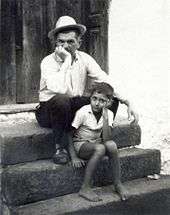
Sasha Savic was born in Zemun, city of Belgrade, Serbia, as a single child of Milorad Savic and Draginja née Jankovic. Father was a Civil engineer and mother worked as a Medical laboratory analyst. Savic spent his childhood in New Belgrade, where he finished elementary school and Ninth Belgrade Gymnasium. He also completed an advanced English language course at The Institute for Foreign Languages. His earliest contact with performing and visual arts, at the age of 16, was through the actor Stanislav Terzin, who created his roles but also his own costumes and masks.
The Art World
After the grammar school, Savic was admitted at the Faculty of Economics, University of Belgrade in 1975. He studied with a lot of success, especially in mathematics, statistics and accounting, but after seeing an exhibition of Salvador Dalí's prints in 1977 in Belgrade and Peter Watkins's series, Portrait of Edvard Munch, shown on a local TV, he decided to continue his career in Arts.
The first Art education Savic got at the Artists’ colony, in Kosutnjak Hills. The distinguished Serbian artists Matija Vukovic, Sinisa Vukovic (founder of MEDIALA) and Vladislav Silja Todorovic were his first mentors, but Sergije Jovanovic[1] at his Art School, got him ready for further studies.
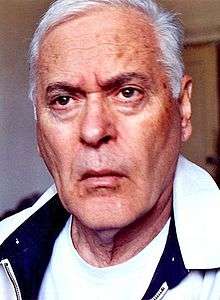
In 1979, Savic enrolled in the Academy of Fine Arts[2] (Fakultet Likovnih Umetnosti), University of Belgrade, Serbia. During the 5+2 years of regular studies at the Academy, his teachers ware: Miodrag Rogic,[3] from the graphics department and painters Slavoljub Cvorovic and Zivojin Turinski.[4]
In 1983. Savic founded the Art magazine FLU and was the first editor in chief. The magazine was financed exclusively by AKADEMIA, the Art Student's Club, situated at the School's underground venue, later famed for being a top discotheque in town and gathering place of Belgrade avant-garde artists. AKADEMIA was also known for organizing and fully financing Art excursions, both domestic and foreign for 100+ students of the final two years. Savic served as the president of the Club from 1984-1986.
While studying Art, Savic visited numerous Museums and exhibitions in Paris, London, Berlin, Amsterdam, Stockholm, Brussels, Düsseldorf, Hamburg, Venice, Florence, Basel, Bern and Barcelona.
During his freshman year, Savic did two stage design projects for the hard rock band Atomic Shelter, for their concerts in Belgrade and Ljubljana (with Bosko Obradovic and Goran Desancic).
Savic graduated in 1984, with BFA and after completing Postgraduate studies got his Master of Arts degree in painting, 1986. His first solo show followed at the Academy's own gallery, in Knez Mihailova Street in Belgrade.
In 1987-1988, Savic spent several months in Denmark, painting and exploring contemporary Scandinavian art (in Århus and Copenhagen) and learning Danish language. At the University of Århus, upon the invitation by professor Henning Mørk and fellow artist Ann Dorte Nielsen, Sasha gave a lecture on Yugoslav Modern Art.
In 1989, Savic was awarded the Norwegian Government scholarship to further develop as an Artist and to study the art of Edvard Munch (whom he considers as a spiritual father). Savic then, preparing for the trip, studies Norwegian language at the Faculty for Philology in Belgrade for two semesters.
In January 1990, Savic travels to Norway. He was hosted by the Ministry of Foreign affairs and based in The Munch Museum in Oslo. There he studied Munch's paintings, drawings and prints in the main gallery and in the Museum's archives with curators Mr Eggum and Mr Thurmann-Moe. The National Gallery in Oslo served as an excellent source for the comparative studies of Munch's works and his contemporaries. The city of Bergen was the next hub with its Rasmus Meyer's huge collection of Munch's paintings. Savic also collaborated with Svein Christiansen of Bergen's KunstForeningen, handling the artworks, preparing the exhibitions and putting the shows in the main gallery. While exploring Munch, being an artist, Savic was granted a special permission to use all the facilities and premises of Bergen's Vestlandets KunstAkademi to create his own artworks. He had tight collaboration with the visiting teachers and School's professors, especially with the Director, painter Morten Krogh.
Byzantine Era

1988, Savic and his fellow artists Lazar Lecic, Goran Desancic and Misha Obrenovic were commissioned by the Abbott of Grabovac[5] monastery (near Belgrade) to paint frescoes on the walls of the interior of the entire church. The work was done in Byzantine fresco-secco technique and it lasted for three full years. The monastery wasn't just a sacred place, but a unique fresco painting School and a workshop, where the young Artists developed their skills, pictorial taste, theoretical knowledge and monastic spirituality. The Abbott, archimandrite Damaskin, was a spiritual father and professor Todic, an expert in Byzantine Art, provided them with subtle details from the history of the profession.
In his work Savic was greatly influenced by Andrei Rublev's icons and 12th - 14th century frescoes from Greece, Serbia and the Middle East.
Savic was baptized in 1989, at the age of 33, in his native Zemun, in the Serbian Orthodox church of St George. The Godfather was a lifelong friend, Misha Devic.
In January 1991, Savic met fellow artist Iskra Bravo in her studio in Belgrade and by March they were married. In April, the same year, Savic travels to Bosnia to join his team in Velika Obarska, for a new fresco painting project. Soon after they started, the civil war broke out in neighboring Croatia. The team went on painting despite the ongoing gunfire just a few miles away. Artists managed to complete their work by the end of September and shortly after, Savic and Bravo went into self-imposed exile by leaving the country.
Holy Land

Savic and his wife docked at the Israeli port of Haifa in November 1991. They were hosted by the legendary artist Avram Omri, who lived and worked in Sha'ar HaAmakim kibbutz in Galilee. The second stop for the couple was the Artists' colony in Safed, close to the Lebanese border. Courtesy to the Colony's President, they got the studio to work on their art. In the beginning of 1992, they moved to Jerusalem, where they met renowned Serbian journalist, Borivoj Erdeljan, Politika's foreign correspondent. Savic would be greatly influenced by journalist's vast experience and open mindedness. In February, The Association of Jerusalem Artists provided a three months residence for the couple in The Hilai Art Center in upper Galilee. Savic and Bravo had tight links with local Artists and with the mixed Arab-Jewish community, working with children on their pictorial education. Savic also gave a lecture on Byzantine Art in Ma'alot's Cultural Center. In April the couple moves to Cana of Galilee, a small town near Nazareth. The Abbott of the Greek Orthodox monastery, later the Patriarch of Jerusalem, Theophilous III,[6] commissioned Sasha to paint several scenes in a true fresco technique in the church famous for the Christ's first Miracle. Sasha did ten huge compositions including The Wedding in Cana, while his wife was helping with the preparation of the cartons for the frescoes.
Cyprus

By the end of 1992, the couple moves to Cyprus, an island in eastern Mediterranean. Savic was quickly engaged by the Bishop of Paphos (now the Archbishop of Cyprus), to paint a number of icons for the church of St Spyridon and for the Synodicon of the Holy Paphos Bishopric. Famous St Lazarus church in Larnaca, Center for Cultural Heritage of Cyprus in Nicosia, St Demetrios church of Aliathon Resort and The Church St Cosma and Damianos in Paphos, commissioned Sasha to paint icons of various sizes.
Despite working mainly for the church, Savic did more than two hundred icons, now being in numerous private collections around the world.
Savic has been living in Cyprus, on and off, for the last 24 years and has painted frescoes for the following churches: Panagia Therapeftria, St Cosma and Damianos, Panagia Pantanassa, St Demetrios of Aliathon, St George by the sea, all in Paphos district.
In 1996, the Patriarch Pavle[7] of Serbia was in his official visit to Cyprus. Savic was introduced to the Patriarch and got engaged in long conversations with him on several occasions during his journey through Cyprus. "Talking with his Beatitude was a great honor and very inspiring, especially on the topics concerning Byzantine Art, history and life in general" said Savic.
.jpg)
In 1996, Savic met Richard Sale, the director of The Monagri Foundation[8] in Cyprus and they became close friends. The foundation provided residences for artists from all over the world. Through Sale and his wife Alison, Sasha met most of the visiting artists personally, collaborating with them on various joint projects. Savic was the last Guest artist to work at the Foundation, before its closure in 2003 (formal in 2007). Being the top Art Center in Cyprus, in its peak years (1993 - 2003), Monagri Foundation, its artists and its spirit, influenced Savic significantly. The result was a creation of new Praxis, the Art group with a strong statement in Nature Art.
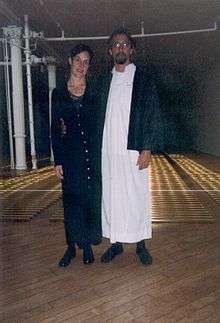
In 1998, through a Cypriot book publisher Ruth Keshishian, Savic met American artist Elizabeth Hoak Doering, who was in Cyprus on a Fulbright grant. They joined forces with Cypriot artists Rinos Stefani and Susan Vargas (of Colombia) to form an Art group. In June that year they made the first joint project The Sphere in Nature resort of Akamas in Cyprus. As Glyn Hughes, famous Welsh painter and art critic, wrote in The Cyprus Weekly..."Praxis" struck again for the sake of art and in the footsteps of Die Brücke, Blue Reiter and Cobra, with its natural reaction to alienation, amateurism and primitivism of modern societies".
The second joint venture happened in the Millennium year of 2000. "The four artists masterfully crafted huge triangle net and stretched it over a small bay in the Akamas, National Park of Cyprus. The sea@net is a triangular net, placed where the sea meets the land... it is parallel to the horizon line, where the sea meets the sky. The triangle references sails, fishermen's nets and structural stability. The triangle is hope for the stable future of nature. And in the title, a recognition of the communication among a particular generation of people who will be responsible for the preservation of land, sea and sky. The sea@net puts forward questions about the future.
American Tour
In 1999, upon the invitation by Georgia College&State University, Savic came to the United States[9] as Artist in residence. Together with Ms Bessie Tina Yarborough,[10] Professor of Art History & Interdisciplinary Studies at GS&SU, Savic organized and conducted a Master class in Byzantine Art and an advanced icon workshop. During that visit Savic explored the American modern art in Pittsburgh, Washington D.C., Philadelphia and New York City.
Recent Years

The past ten years Savic partnered with the Cypriot artist of Armenian descent, Tatiana Ferahian.[11] The couple traveled the world installing Tatiana's Nature Art works at the world-famous Art venues, exhibitions and Symposiums: Forth Beijing Art Biennale 2008, China; Second SHINGLE22j, Anzio & Nettuno Biennale of Contemporary Art 2009, Italy; OUT of SPACE,[12] Art in Nature Symposium 2010, Holland; LITTLE LAND FISH 2010, Sanat Liman, Istanbul, Turkey; YATOO, Geumgang Nature Art Biennale 2012, Gongju, South Korea; Fifth Beijing Art Biennale 2012, China; I-Park Foundation 2013 Environmental Art Biennale,[13] Connecticut, USA; ENTRE-LAC, Nature Art Symposium 2014, Lille, France; SHINGLE22j, 2015 Biennale d'Arte Contemporanea di Anzio e Nettuno,[14] Italy...
Savic is fluent in Serbian, English and Greek, but can manage in several other languages.
The Art-house Films are Savic's passion. He has a digital collection of more than 1000 masterpieces.
Savic participated in numerous group exhibitions with his installations, portraits and paintings. PERSPEKTIVE XII and OCTOBER SALON 1984 in Belgrade, Various ULUS, Serbian Association of Fine Arts exhibitions, YUGOSLAV PORTRAIT exhibitions in Tuzla, MASTERS of the '80, FIRST FINE ARTS FESTIVAL in Nicosia, Various E.KA.TE, Cyprus Chambers of Fine Arts shows, WITHIN-WITHOUT in Paphos, THIRD MILLENNIUM in Nicosia, ANTI-WAR show in Paphos, URBAN SOUL FESTIVALS,[15] Tripoli Park, Nicosia, SALAD BOWL in Tampere,[16] Finland and in Paphos, Cyprus, ART OF DENIAL[17] in Paphos.
He is a member of ULUS, Serbian Association of Fine Arts, since 1985 and E.KA.TE, Cyprus Chambers of Fine Arts, since 1995.
Selected Works
 St Demetrios Church, Aliathon, Paphos, Cyprus 2016
St Demetrios Church, Aliathon, Paphos, Cyprus 2016 St Demetrios Church, Aliathon, Paphos, Cyprus 2016
St Demetrios Church, Aliathon, Paphos, Cyprus 2016 St Demetrios Church, Aliathon, Paphos, Cyprus 2016
St Demetrios Church, Aliathon, Paphos, Cyprus 2016 Angels for Center for Cultural Heritage of Cyprus, 60x80cm, Linden wood, egg-tempera, gilding on bole
Angels for Center for Cultural Heritage of Cyprus, 60x80cm, Linden wood, egg-tempera, gilding on bole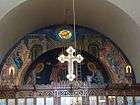 Cosma and Damianos church, Paphos, Cyprus 2006 fresco-secco Width12m
Cosma and Damianos church, Paphos, Cyprus 2006 fresco-secco Width12m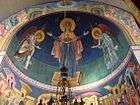 Cosma and Damianos church, Paphos, Cyprus 2006a
Cosma and Damianos church, Paphos, Cyprus 2006a.jpg) 2D Resting Facility, Nicosia (2010)
2D Resting Facility, Nicosia (2010)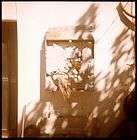 Millenium X, Paphos, Cyprus 1999, 100x100cm, metal, plastic, concrete
Millenium X, Paphos, Cyprus 1999, 100x100cm, metal, plastic, concrete
Photographs
 Manhattan_Panorama_Calvary_Cemetery (Queens, New York City) Sasa M.Savic, 2013 Sony DSC-H10
Manhattan_Panorama_Calvary_Cemetery (Queens, New York City) Sasa M.Savic, 2013 Sony DSC-H10
References
- ↑ "Profesor Sergije Jovanović"
- ↑ Faculty of Fine Arts
- ↑ Miodrag Rogic
- ↑ Zivojin Turinski
- ↑ Manastir Grabovac, Živopis
- ↑ Jerusalimski oganj, DANAS 4.MAJ 2016
- ↑ Srđan Đile Marković, Sub.22. - Ned.23. april 2006,"Freske, čitanke za narod" ("Frescos, Pictorial Alphabet for the People"), Beogradski slikar Saša Savić, freskopisac u Jerusalimu, na Kipru, u Grčkoj, (The artist Sasa Savic, Begrade native, on a fresco mission in Jerusalem, Cyprus, Greece), GLAS (VOICE), Beograd, SRBIJA I CRNA GORA
- ↑ The Monagri Foundation
- ↑ Glyn Hughes, Mar.31 - Apr.6, 2000 "Sasa Savic goes to USA letting the light shine in", The CYPRUS WEEKLY, Nicosia, CYPRUS
- ↑ Bessie R. Tina Yarborough, Initiated & organized an icon painting workshop on campus with Sasa Savic, 1999
- ↑ Tatiana Ferahian
- ↑ Symposium "Out of Space", Wettlands "De Rottige Meente", Netherlands
- ↑ I-Park, 2013 Environmental Art Biennale
- ↑ "Shingle22j", Edizione 2015
- ↑ Pantheon Urban Soul Festival 4.0, 2. ART SCENE
- ↑ "Salad Bowl" Brochure
- ↑ "Art of Denial", curated by Tatiana Ferahian
External links
- Beach News Online Cyprus News Free News Paper
- Freske, čitanke za narod, Glas Javnosti
- Jerusalimski oganj, DANAS 4.MAJ 2016
- Manastir Grabovac, Živopis
Category:Articles created via the Article Wizard
